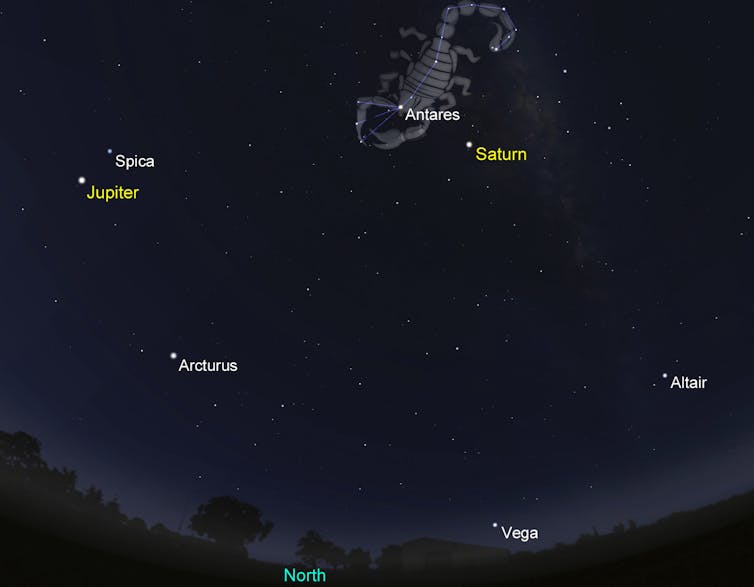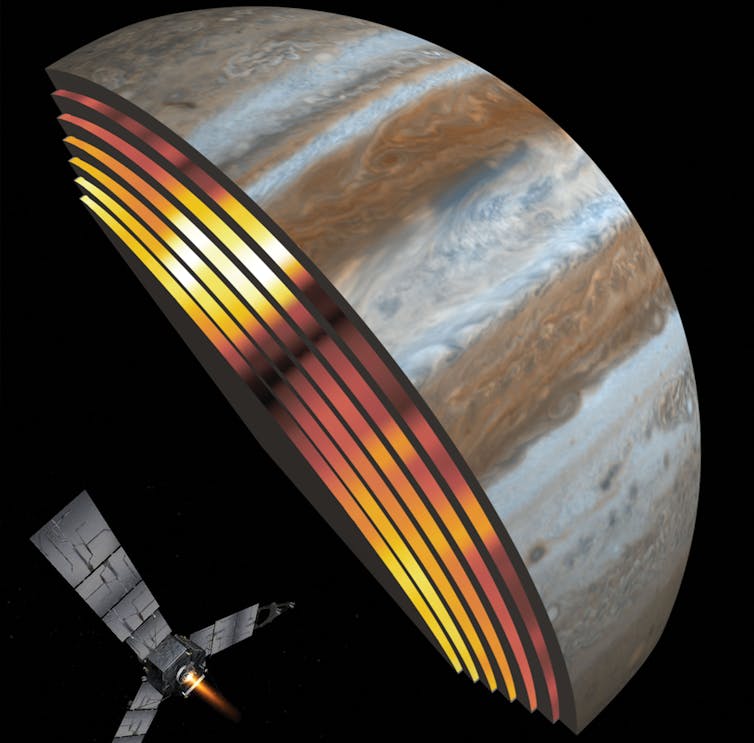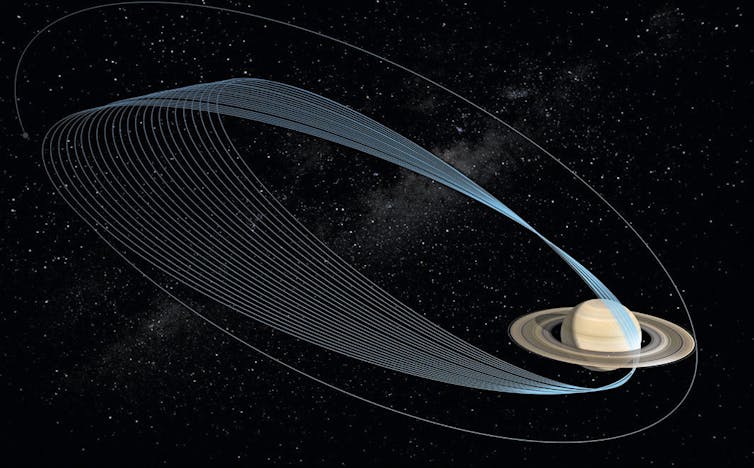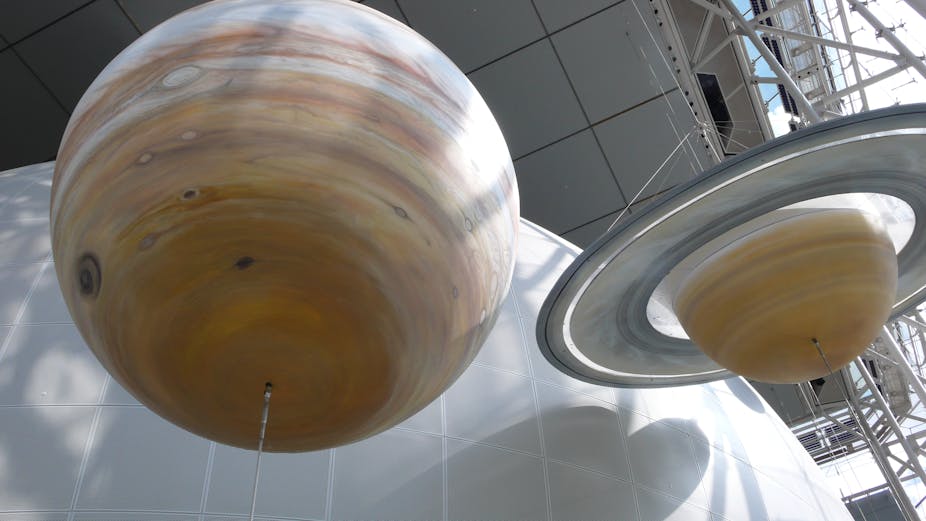Look towards north after sunset and the two gas giant planets, Jupiter and Saturn, can be seen among the stars.
Jupiter is named for the Roman king of the gods and its great size allows it to shine with a brilliant steady light. In fact, Jupiter is really easy to find as it’s the brightest object in the northwest sky at the moment.
Saturn, according to Roman mythology, is Jupiter’s father. Being the elder, it is the slowest and most distant planet that can be seen with the naked eye. Saturn takes 29 years to orbit the Sun, which is as long as the average lifespan back in Roman times. You must have been doing well if you saw one complete revolution of Saturn.
To find Saturn you have to hunt a little harder than Jupiter. It is high in the northern sky and shines with a steady yellowish glow below the winter constellation of Scorpius.

What’s more, as father and son team up in the night sky, they both have impressive spacecraft in orbit.
The Juno spacecraft reached Jupiter in July last year and has at least another year of its main mission to complete.
On the other hand, the Cassini spacecraft is a veteran. It has been in orbit around Saturn for the past 13 years, but its mission is now coming to an end. With the spacecraft low on fuel, Cassini’s course is set and it will plunge into Saturn’s atmosphere on September 15.
Slow and steady
In the past year, Juno has completed seven close passes of Jupiter. It was supposed to have completed more than 30 orbits by now, but a technical fault has meant that the spacecraft is stuck on a long 53-day orbit, rather than dropping to the originally planned 11-day orbit.
This hasn’t stopped Juno delivering great science, it’s just going to take a bit longer. During its most recent close encounter with Jupiter, the spacecraft flew right over Jupiter’s iconic Great Red Spot and delivered some of the most detailed pictures yet of the majestic, swirling storm.
But the main focus of Juno’s mission is to understand what’s going on below the cloud tops, where such images can’t penetrate. When we look at Jupiter in optical light, either with our eyes at night or with the spacecraft’s Junocam, what we see is sunlight bouncing off Jupiter’s upper cloud levels.

At longer wavelengths, it’s possible to peer through the cloud layers and directly detect the energy emitted by Jupiter’s hot gas.
Juno is fitted with microwave radiometers that can observe light emerging from hundreds of kilometres below Jupiter’s cloud tops. Early science results, based on Juno’s first flyby, already suggest that Jupiter’s distinct banding of light-coloured zones and dark-coloured belts extends down to 350km but varies with depth. It seems that Jupiter’s weather is much more than skin-deep.
Growing family
Jupiter is the most massive planet in our solar system and not too surprisingly, it also has the largest family. Just recently two small moonlets were discovered adding to the family. They are just a couple of kilometres across and have increased Jupiter’s moons to an impressive count of 69.
The new moons are a relatively long way from Jupiter, with an average distance of more than 20-million kilometres. For comparison, Jupiter’s four main moons - the Galilean satellites of Io, Europa, Ganymede and Callisto - orbit within 2-million kilometres.
But two-thirds of Jupiter’s moons orbit at such great distances, many millions of kilometres from the planet. What’s more, these moons all follow retrograde orbits, meaning they orbit Jupiter in the opposite direction to the way Jupiter spins. This is a tell-tale sign that Jupiter likely captured these moons at some stage.
Tugged by Titan
Saturn’s count of 62 known moons, is right up there with Jupiter’s. However, unlike Jupiter, Saturn has only one major moon. Titan is a little larger than the planet Mercury and the Cassini mission has shown it to be a marvellous world with lakes, clouds and rain all made of methane.
Titan has been crucial for the Cassini mission – not only because it was another world to explore but because the moon’s gravitational tugs on Cassini have allowed the spacecraft to move all over the Saturn system, changing the shape and size of Cassini’s orbit.
Cassini has been able to explore different regions of Saturn and zip out to flyby Saturn’s various distant moons without the need of additional fuel or use of its thrusters.

Last April, a close encounter with Titan set Cassini up for its Grand Finale. It modified Cassini’s orbit, switching things up so that instead of flying outside of Saturn’s rings it began diving through the gap between the rings and the planet.
Another distant encounter with Titan on September 11, will push Cassini towards the planet itself. A few days, later Cassini will plunge into Saturn’s atmosphere making measurements until its very final moments. But ultimately, as Cassini battles Saturn’s atmosphere, the spacecraft is doomed to be vapourised like a bright meteor in the Saturn sky.

